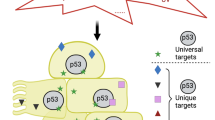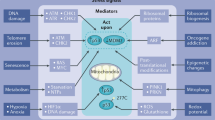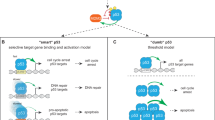Abstract
p53 is arguably the most intensively studied protein to date, yet there is much that we ignore about its function as a transcription factor. The p53-dependent transcriptional program is remarkably flexible, as it varies with the nature of p53-activating stimuli, the cell type and the duration of the activation signal. This flexibility may allow cells to mount alternative responses to p53 activation, such as cell cycle arrest or apoptosis. Here, I organize the available data into two alternative models to explain how this regulatory diversity is achieved.
This is a preview of subscription content, access via your institution
Access options
Subscribe to this journal
Receive 50 print issues and online access
$259.00 per year
only $5.18 per issue
Buy this article
- Purchase on SpringerLink
- Instant access to full article PDF
Prices may be subject to local taxes which are calculated during checkout


Similar content being viewed by others
References
Albright SR, Tjian R . (2000). TAFs revisited: more data reveal new twists and confirm old ideas. Gene 242: 1–13.
Alves NL, Derks IA, Berk E, Spijker R, van Lier RA, Eldering E . (2006). The Noxa/Mcl-1 axis regulates susceptibility to apoptosis under glucose limitation in dividing T cells. Immunity 24: 703–716.
Bergamaschi D, Samuels Y, Jin B, Duraisingham S, Crook T, Lu X . (2004). ASPP1 and ASPP2: common activators of p53 family members. Mol Cell Biol 24: 1341–1350.
Bergamaschi D, Samuels Y, Sullivan A, Zvelebil M, Breyssens H, Bisso A et al. (2006). iASPP preferentially binds p53 proline-rich region and modulates apoptotic function of codon 72-polymorphic p53. Nat Genet 38: 1133–1141.
Bourdon JC, Fernandes K, Murray-Zmijewski F, Liu G, Diot A, Xirodimas DP et al. (2005). p53 isoforms can regulate p53 transcriptional activity. Genes Dev 19: 2122–2137.
Brunkhorst A, Neuman T, Hall A, Arenas E, Bartfai T, Hermanson O et al. (2004). Novel isoforms of the TFIID subunit TAF4 modulate nuclear receptor-mediated transcriptional activity. Biochem Biophys Res Commun 325: 574–579.
Bunz F, Hwang PM, Torrance C, Waldman T, Zhang Y, Dillehay L et al. (1999). Disruption of p53 in human cancer cells alters the responses to therapeutic agents. J Clin Invest 104: 263–269.
Butler JE, Kadonaga JT . (2001). Enhancer-promoter specificity mediated by DPE or TATA core promoter motifs. Genes Dev 15: 2515–2519.
Butler JE, Kadonaga JT . (2002). The RNA polymerase II core promoter: a key component in the regulation of gene expression. Genes Dev 16: 2583–2592.
Cain C, Miller S, Ahn J, Prives C . (2000). The N terminus of p53 regulates its dissociation from DNA. J Biol Chem 275: 39944–39953.
Chen JL, Attardi LD, Verrijzer CP, Yokomori K, Tjian R . (1994). Assembly of recombinant TFIID reveals differential coactivator requirements for distinct transcriptional activators. Cell 79: 93–105.
Chen L, Willis SN, Wei A, Smith BJ, Fletcher JI, Hinds MG et al. (2005). Differential targeting of prosurvival Bcl-2 proteins by their BH3-only ligands allows complementary apoptotic function. Mol Cell 17: 393–403.
Contente A, Dittmer A, Koch MC, Roth J, Dobbelstein M . (2002). A polymorphic microsatellite that mediates induction of PIG3 by p53. Nat Genet 30: 315–320.
Das S, Raj L, Zhao B, Kimura Y, Bernstein A, Aaronson SA et al. (2007). Hzf determines cell survival upon genotoxic stress by modulating p53 transactivation. Cell 130: 624–637.
Davison TS, Vagner C, Kaghad M, Ayed A, Caput D, Arrowsmith CH . (1999). p73 and p63 are homotetramers capable of weak heterotypic interactions with each other but not with p53. J Biol Chem 274: 18709–18714.
Donner AJ, Hoover JM, Szostek SA, Espinosa JM . (2007a). Stimulus-specific transcriptional regulation within the p53 network. Cell Cycle 6: 2594–2598.
Donner AJ, Szostek S, Hoover JM, Espinosa JM . (2007b). CDK8 is a stimulus-specific positive coregulator of p53 target genes. Mol Cell 27: 121–133.
Efeyan A, Ortega-Molina A, Velasco-Miguel S, Herranz D, Vassilev LT, Serrano M . (2007). Induction of p53-dependent senescence by the MDM2 antagonist nutlin-3a in mouse cells of fibroblast origin. Cancer Res 67: 7350–7357.
el-Deiry WS, Kern SE, Pietenpol JA, Kinzler KW, Vogelstein B . (1992). Definition of a consensus binding site for p53. Nat Genet 1: 45–49.
Espinosa JM, Emerson BM . (2001). Transcriptional regulation by p53 through intrinsic DNA/chromatin binding and site-directed cofactor recruitment. Mol Cell 8: 57–69.
Espinosa JM, Verdun RE, Emerson BM . (2003). p53 functions through stress- and promoter-specific recruitment of transcription initiation components before and after DNA damage. Mol Cell 12: 1015–1027.
Fei P, Bernhard EJ, El-Deiry WS . (2002). Tissue-specific induction of p53 targets in vivo. Cancer Res 62: 7316–7327.
Figueroa A, Cuadrado A, Fan J, Atasoy U, Muscat GE, Munoz-Canoves P et al. (2003). Role of HuR in skeletal myogenesis through coordinate regulation of muscle differentiation genes. Mol Cell Biol 23: 4991–5004.
Flores ER, Tsai KY, Crowley D, Sengupta S, Yang A, McKeon F et al. (2002). p63 and p73 are required for p53-dependent apoptosis in response to DNA damage. Nature 416: 560–564.
Garneau NL, Wilusz J, Wilusz CJ . (2007). The highways and byways of mRNA decay. Nat Rev Mol Cell Biol 8: 113–126.
Gohler T, Reimann M, Cherny D, Walter K, Warnecke G, Kim E et al. (2002). Specific interaction of p53 with target binding sites is determined by DNA conformation and is regulated by the C-terminal domain. J Biol Chem 277: 41192–41203.
Gomes NP, Bjerke G, Llorente B, Szostek SA, Emerson BM, Espinosa JM . (2006). Gene-specific requirement for P-TEFb activity and RNA polymerase II phosphorylation within the p53 transcriptional program. Genes Dev 20: 601–612.
Gorina S, Pavletich NP . (1996). Structure of the p53 tumor suppressor bound to the ankyrin and SH3 domains of 53BP2. Science 274: 1001–1005.
Guenther MG, Levine SS, Boyer LA, Jaenisch R, Young RA . (2007). A chromatin landmark and transcription initiation at most promoters in human cells. Cell 130: 77–88.
Hermeking H . (2007). p53 enters the microRNA world. Cancer Cell 12: 414–418.
Hoh J, Jin S, Parrado T, Edington J, Levine AJ, Ott J . (2002). The p53MH algorithm and its application in detecting p53-responsive genes. Proc Natl Acad Sci USA 99: 8467–8472.
Horvath MM, Wang X, Resnick MA, Bell DA . (2007). Divergent evolution of human p53 binding sites: cell cycle versus apoptosis. PLoS Genet 3: e127.
Jett SD, Cherny DI, Subramaniam V, Jovin TM . (2000). Scanning force microscopy of the complexes of p53 core domain with supercoiled DNA. J Mol Biol 299: 585–592.
Jiang M, Milner J . (2003). Bcl-2 constitutively suppresses p53-dependent apoptosis in colorectal cancer cells. Genes Dev 17: 832–837.
Johannessen LE, Knardal SL, Madshus IH . (1999). Epidermal growth factor increases the level of the cyclin-dependent kinase (CDK) inhibitor p21/CIP1 (CDK-interacting protein 1) in A431 cells by increasing the half-lives of the p21/CIP1 transcript and the p21/CIP1 protein. Biochem J 337 (Part 3): 599–606.
Kaeser MD, Iggo RD . (2002). Chromatin immunoprecipitation analysis fails to support the latency model for regulation of p53 DNA binding activity in vivo. Proc Natl Acad Sci USA 99: 95–100.
Kojima K, Konopleva M, Samudio IJ, Shikami M, Cabreira-Hansen M, McQueen T et al. (2005). MDM2 antagonists induce p53-dependent apoptosis in AML: implications for leukemia therapy. Blood 106: 3150–3159.
Lal A, Mazan-Mamczarz K, Kawai T, Yang X, Martindale JL, Gorospe M . (2004). Concurrent versus individual binding of HuR and AUF1 to common labile target mRNAs. EMBO J 23: 3092–3102.
Laptenko O, Prives C . (2006). Transcriptional regulation by p53: one protein, many possibilities. Cell Death Differ 13: 951–961.
Lemon B, Inouye C, King DS, Tjian R . (2001). Selectivity of chromatin-remodelling cofactors for ligand-activated transcription. Nature 414: 924–928.
Loncle N, Boube M, Joulia L, Boschiero C, Werner M, Cribbs DL et al. (2007). Distinct roles for mediator Cdk8 module subunits in Drosophila development. EMBO J 26: 1045–1054.
Ludwig RL, Bates S, Vousden KH . (1996). Differential activation of target cellular promoters by p53 mutants with impaired apoptotic function. Mol Cell Biol 16: 4952–4960.
Luecke HF, Yamamoto KR . (2005). The glucocorticoid receptor blocks P-TEFb recruitment by NFkappaB to effect promoter-specific transcriptional repression. Genes Dev 19: 1116–1127.
Mattia M, Gottifredi V, McKinney K, Prives C . (2007). p53-dependent p21 mRNA elongation is impaired when DNA replication is stalled. Mol Cell Biol 27: 1309–1320.
Mo X, Kowenz-Leutz E, Xu H, Leutz A . (2004). Ras induces mediator complex exchange on C/EBP beta. Mol Cell 13: 241–250.
Moll UM, Slade N . (2004). p63 and p73: roles in development and tumor formation. Mol Cancer Res 2: 371–386.
O'Brien T, Lis JT . (1991). RNA polymerase II pauses at the 5′ end of the transcriptionally induced Drosophila hsp70 gene. Mol Cell Biol 11: 5285–5290.
Oda K, Arakawa H, Tanaka T, Matsuda K, Tanikawa C, Mori T et al. (2000). p53AIP1, a potential mediator of p53-dependent apoptosis, and its regulation by Ser-46-phosphorylated p53. Cell 102: 849–862.
Perez CA, Ott J, Mays DJ, Pietenpol JA . (2007). p63 consensus DNA-binding site: identification, analysis and application into a p63MH algorithm. Oncogene 26: 7363–7370.
Resnick-Silverman L, St Clair S, Maurer M, Zhao K, Manfredi JJ . (1998). Identification of a novel class of genomic DNA-binding sites suggests a mechanism for selectivity in target gene activation by the tumor suppressor protein p53. Genes Dev 12: 2102–2107.
Samuels-Lev Y, O'Connor DJ, Bergamaschi D, Trigiante G, Hsieh JK, Zhong S et al. (2001). ASPP proteins specifically stimulate the apoptotic function of p53. Mol Cell 8: 781–794.
Senoo M, Manis JP, Alt FW, McKeon F . (2004). p63 and p73 are not required for the development and p53-dependent apoptosis of T cells. Cancer Cell 6: 85–89.
Seoane J, Le HV, Massague J . (2002). Myc suppression of the p21(Cip1) Cdk inhibitor influences the outcome of the p53 response to DNA damage. Nature 419: 729–734.
Shi L, Zhao G, Qiu D, Godfrey WR, Vogel H, Rando TA et al. (2005). NF90 regulates cell cycle exit and terminal myogenic differentiation by direct binding to the 3′-untranslated region of MyoD and p21WAF1/CIP1 mRNAs. J Biol Chem 280: 18981–18989.
Shu L, Yan W, Chen X . (2006). RNPC1, an RNA-binding protein and a target of the p53 family, is required for maintaining the stability of the basal and stress-induced p21 transcript. Genes Dev 20: 2961–2972.
Slee EA, Lu X . (2003). The ASPP family: deciding between life and death after DNA damage. Toxicol Lett 139: 81–87.
Sykes SM, Mellert HS, Holbert MA, Li K, Marmorstein R, Lane WS et al. (2006). Acetylation of the p53 DNA-binding domain regulates apoptosis induction. Mol Cell 24: 841–851.
Szak ST, Mays D, Pietenpol JA . (2001). Kinetics of p53 binding to promoter sites in vivo. Mol Cell Biol 21: 3375–3386.
Tanaka T, Ohkubo S, Tatsuno I, Prives C . (2007). hCAS/CSE1L associates with chromatin and regulates expression of select p53 target genes. Cell 130: 638–650.
Tang Y, Luo J, Zhang W, Gu W . (2006). Tip60-dependent acetylation of p53 modulates the decision between cell-cycle arrest and apoptosis. Mol Cell 24: 827–839.
Thompson T, Tovar C, Yang H, Carvajal D, Vu BT, Xu Q et al. (2004). Phosphorylation of p53 on key serines is dispensable for transcriptional activation and apoptosis. J Biol Chem 279: 53015–53022.
Toledo F, Wahl GM . (2006). Regulating the p53 pathway: in vitro hypotheses, in vivo veritas. Nat Rev Cancer 6: 909–923.
Tovar C, Rosinski J, Filipovic Z, Higgins B, Kolinsky K, Hilton H et al. (2006). Small-molecule MDM2 antagonists reveal aberrant p53 signaling in cancer: implications for therapy. Proc Natl Acad Sci USA 103: 1888–1893.
Truong AB, Kretz M, Ridky TW, Kimmel R, Khavari PA . (2006). p63 regulates proliferation and differentiation of developmentally mature keratinocytes. Genes Dev 20: 3185–3197.
van de Peppel J, Kettelarij N, van Bakel H, Kockelkorn TT, van Leenen D, Holstege FC . (2005). Mediator expression profiling epistasis reveals a signal transduction pathway with antagonistic submodules and highly specific downstream targets. Mol Cell 19: 511–522.
Vassilev LT, Vu BT, Graves B, Carvajal D, Podlaski F, Filipovic Z et al. (2004). In vivo activation of the p53 pathway by small-molecule antagonists of MDM2. Science 303: 844–848.
Vives V, Slee EA, Lu X . (2006a). ASPP2: a gene that controls life and death in vivo. Cell Cycle 5: 2187–2190.
Vives V, Su J, Zhong S, Ratnayaka I, Slee E, Goldin R et al. (2006b). ASPP2 is a haploinsufficient tumor suppressor that cooperates with p53 to suppress tumor growth. Genes Dev 20: 1262–1267.
Wahl GM, Carr AM . (2001). The evolution of diverse biological responses to DNA damage: insights from yeast and p53. Nat Cell Biol 3: E277–E286.
Wang G, Balamotis MA, Stevens JL, Yamaguchi Y, Handa H, Berk AJ . (2005). Mediator requirement for both recruitment and postrecruitment steps in transcription initiation. Mol Cell 17: 683–694.
Wei CL, Wu Q, Vega VB, Chiu KP, Ng P, Zhang T et al. (2006). A global map of p53 transcription-factor binding sites in the human genome. Cell 124: 207–219.
Westfall MD, Mays DJ, Sniezek JC, Pietenpol JA . (2003). The Delta Np63 alpha phosphoprotein binds the p21 and 14-3-3 sigma promoters in vivo and has transcriptional repressor activity that is reduced by Hay-Wells syndrome-derived mutations. Mol Cell Biol 23: 2264–2276.
Yang A, Walker N, Bronson R, Kaghad M, Oosterwegel M, Bonnin J et al. (2000). p73-deficient mice have neurological, pheromonal and inflammatory defects but lack spontaneous tumours. Nature 404: 99–103.
Yang X, Jones RA, Wiester MJ . (2004). A nanoscale slipped sandwich of Tb(10)-stabilization of a benzaldehyde methyl hemiacetyl. Dalton Trans June 21: 1787–1788.
Zhang X, Krutchinsky A, Fukuda A, Chen W, Yamamura S, Chait BT et al. (2005). MED1/TRAP220 exists predominantly in a TRAP/mediator subpopulation enriched in RNA polymerase II and is required for ER-mediated transcription. Mol Cell 19: 89–100.
Zhao R, Gish K, Murphy M, Yin Y, Notterman D, Hoffman WH et al. (2000). Analysis of p53-regulated gene expression patterns using oligonucleotide arrays. Genes Dev 14: 981–993.
Zhou BP, Liao Y, Xia W, Spohn B, Lee MH, Hung MC . (2001). Cytoplasmic localization of p21Cip1/WAF1 by Akt-induced phosphorylation in HER-2/neu-overexpressing cells. Nat Cell Biol 3: 245–252.
Acknowledgements
I thank Aaron Donner, Nathan Gomes, Gerard Evan and Carol Prives for reading the paper and providing useful critiques. I also thank Dr Jim Bridwell for providing support and inspiration. Work in my lab is currently supported by grants from NIH (RO1-CA117907) and March of Dimes (5-FY05-1217).
Author information
Authors and Affiliations
Corresponding author
Rights and permissions
About this article
Cite this article
Espinosa, J. Mechanisms of regulatory diversity within the p53 transcriptional network. Oncogene 27, 4013–4023 (2008). https://doi.org/10.1038/onc.2008.37
Received:
Revised:
Accepted:
Published:
Issue Date:
DOI: https://doi.org/10.1038/onc.2008.37
Keywords
This article is cited by
-
Erythropoietin inhibits chemotherapy-induced cell death and promotes a senescence-like state in leukemia cells
Cell Death & Disease (2019)
-
Identification of p53-target genes in Danio rerio
Scientific Reports (2016)
-
Gradual reduction in rRNA transcription triggers p53 acetylation and apoptosis via MYBBP1A
Scientific Reports (2015)
-
Role of the nucleus in apoptosis: signaling and execution
Cellular and Molecular Life Sciences (2015)
-
Identification of new p53 target microRNAs by bioinformatics and functional analysis
BMC Cancer (2013)



